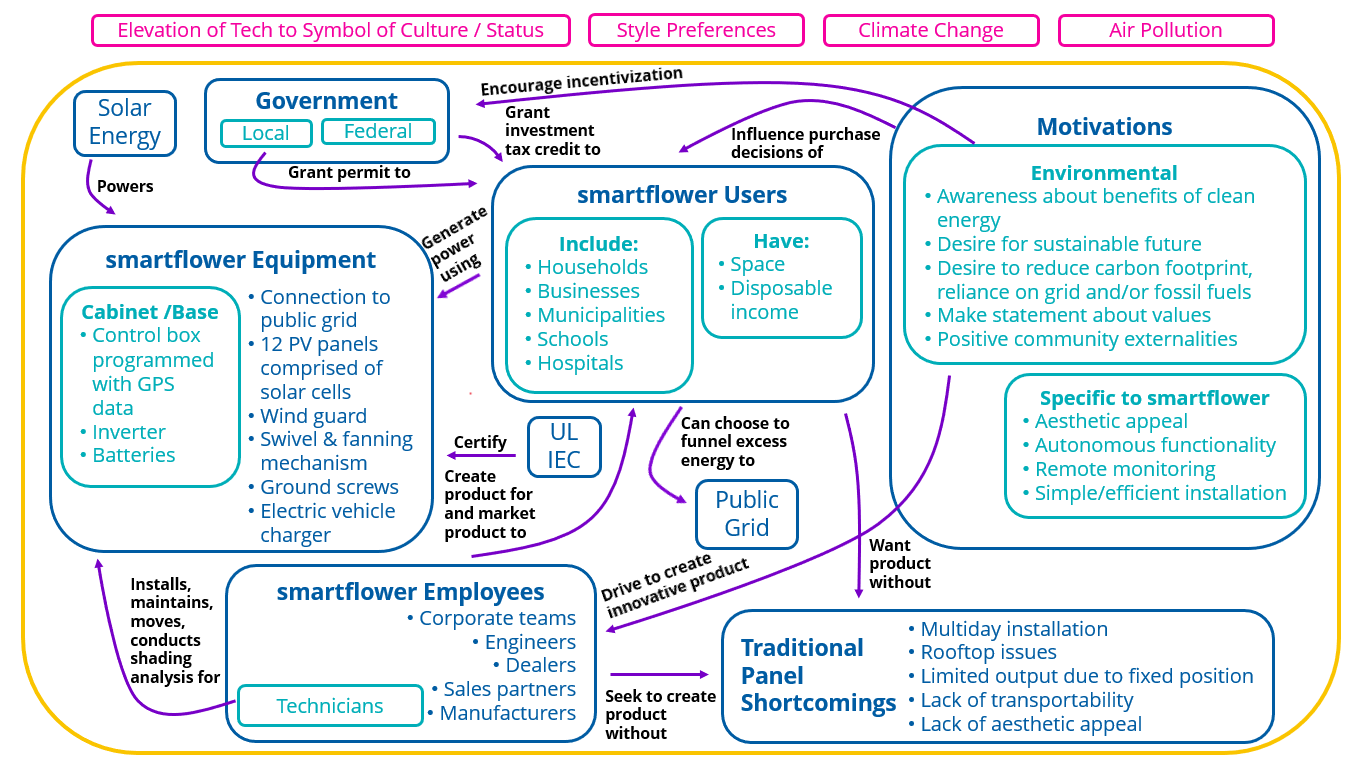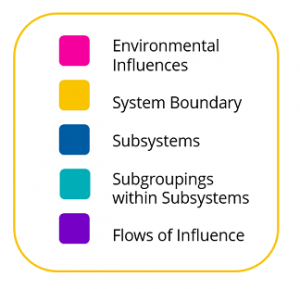Analysis
smartflower takes a unique approach to generating solar power. The diagram below depicts the myriad influences motivating its producers and users within the realm of contemporary solar energy production.
As a solar technology, smartflower’s unconventionality stems from its brief installation process, its transportability, its flower-shaped arrangement of photovoltaic panels, and its self-cleaning, cooling, and safety features. The autonomous movement of its panels on two axes differentiates smartflower from traditional rooftop solar panels, which generally remain affixed to rooftops at stationary angles. Their static position limits the amount of sunlight they can absorb and the amount of energy they can produce. The simultaneous tilting and rotation of smartflower’s panels allows it to produce up to forty percent more power than a standard rooftop system. smartflower owners can also remotely monitor their device’s status and output from their computers or smartphones.
Though smartflower is not the only solar system that changes angles using GPS technology to track the sun, one differentiating feature is that it can be moved (by a certified smartflower technician) from location to location. It can be uninstalled and reinstalled in less than a day if its owner moves to a new residence. Whereas rooftop- and ground-mounted solar panels are typically permanent investments confined to a single location, smartflower’s all-in-one design affords its owners the flexibility to bring their solar system if they move.
smartflower’s creators’ main objective may have been to create an environmentally-friendly means of producing electricity, but they also paid copious amounts of attention to their product’s appearance during its development phase. As a result, consumers who desire to showcase their clean energy usage now have an artistic option for doing so. (In recent years, many aesthetic improvements to traditional solar systems have been geared toward ensuring that panels blend in, rather than stand out.) In the same way that Apple has created devices that are as revered for their design as for their utility, smartflower was invented to reach a clientele seeking a stylish approach to solar power.
Mobility and modernity, however, do not equate to accessibility. smartflower’s size and price point limit its pool of potential purchasers to a small population. Even though smartflower arrives in a compact package, it requires an area of 16’ by 16’ by 16’ to operate once its panels unfold. Given smartflower’s dimensions and space requirements, an interested buyer living in a multi-family setting, such as an apartment or condominium, would likely be unable to utilize this product. Moreover, the device costs between twenty and thirty thousand dollars – even after a federal tax credit has been applied. Its price point limits its ownership to buyers who have a large amount of outdoor space in an area with adequate sunlight – as well as a large amount of disposable income. Owning this product then makes a statement about not only what one values, but about what one can afford to value.
But while smartflower might be out of reach for many, the device was designed with audiences beyond individual homeowners in mind. Owners of businesses – with sufficient resources – could also potentially invest in solar energy through smartflower. One of the device’s key social benefits is that when the home to which smartflower is connected is sufficiently powered and the batteries are full, extra power can be routed to the public grid for use by the community.
From a policy standpoint, smartflower is one player in the larger system of federal incentivization of renewable energy technologies. At various levels, the government incentivizes investing in solar energy production for residential or commercial purposes. The government recognizes the need for and value of clean energy, and a tax credit is a practical way to encourage positive practices. The investment tax credit, also known as the federal solar tax credit, allows a smartflower purchaser to deduct thirty percent of the cost of implementation, thereby reducing the cost of transitioning to renewable energy.
Additionally, because (1) nearly all of smartflower’s components are housed in its base and (2) it can be moved with relative ease from one place to another, it can be used in locations where crises have hit. It can also be used in areas where electricity-producing technologies might be difficult to acquire and maintain. For example, a municipality could purchase smartflower for a park setting, using smartflower to power a stage for local theatre or provide lighting for a baseball field. The context within which smartflower operates determines whether its usage is exclusive or inclusive.

